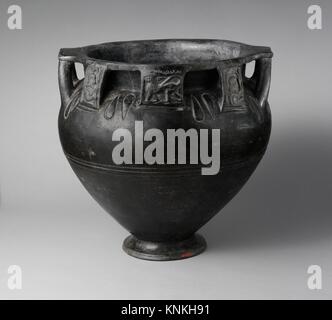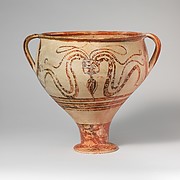

Text from: /works_of_Art/viewOne.asp?dep=13&vie. (82.5 cm) Classification: Vases Credit Line: Rogers Fund, 1914 Accession Number: 14.130. 725 BCE Culture: Greek, Attic Medium: Terracotta Dimensions: H.

The figures may refer to the military exploits of the deceased however, as hourglass shields and chariots played a more limited role at this time than in the earlier Bronze Age, the scene more likely evokes the glorious ancestry and traditions to which the dead man belonged. Title: Terracotta krater Artist: Attributed to the Trachones Workshop Period: Geometric Date: ca. The zone below shows a procession of chariots and foot soldiers. For optimal clarity, the dead man is shown on his side and the checkered shroud that would normally cover the body has been raised and regularized into a long rectangle with two projections. Created by Beth Harris and Steven Zucker. 750-735 B.C.E., Ancient Greece, terracotta, 108.3 x 72.4 cm (The Metropolitan Museum of Art, New York) Speakers: Dr. On this magnificent krater, the main scene, which occupies the widest portion of the vase, shows the deceased laid upon a bier surrounded by members of his household and, at either side, mourners. Terracotta chariot krater The Metropolitan Museum of Art New York City, United States Download this artwork (provided by The Metropolitan Museum of Art). Terracotta Krater, attributed to the Hirschfeld Workshop, Geometric, c.

It was only in the Archaic period that stone sculptures were used as funerary monuments. (72.4 cm)ĭuring the Geometric period, monumental grave markers were introduced in the form of large vases, often decorated with funerary representations.


 0 kommentar(er)
0 kommentar(er)
